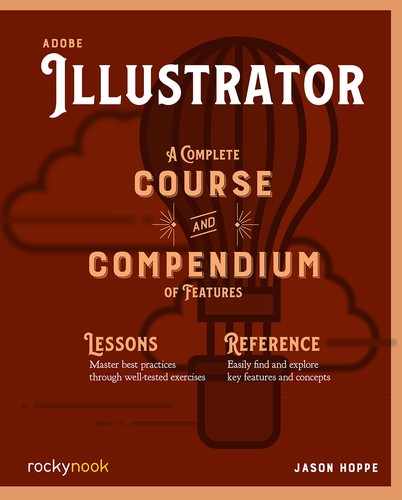Appearance Panel
The Appearance panel lets you make changes to properties like opacity, blending mode, stroke, and fill. It also gives you control over the effects that are applied to objects. The fill and stroke colors, as well as other attributes, are also in the Properties panel and the control bar. The Appearance panel gives the most comprehensive control over object attributes.

Stroke Panel
Stroke attributes appear when you click on the underlined Stroke link in the Appearance panel. The Stroke panel can also be opened as a free-floating panel under Window > Stroke.
Stroke weight is controlled by entering the value in the stroke entry field or by clicking on the dropdown menu next to the stroke value. Choose from the list of preset stroke weights or by clicking on the up or down arrows to the left of the stroke field.

Stroke End Caps are how the ends of an open line appear. The default is to have a Butt Cap where the line ends at a perpendicular point. The second option is the Round Cap (which I call the “hot dog,” based on how it looks) at the end of a line. The third option is the Projecting Cap, which adds an equal amount of line stroke to the end of the line.

Stroke corner styles are for closed shapes. There are three styles: Miter Join, Round Join, and Bevel Join. These styles apply to the stroke only and not to the shape. If these are applied to a shape with no stroke, nothing will appear. Use corner widgets to apply these styles to the shape’s corners.

Miter limit settings are for shapes set with Miter Join corners. Objects that form tight angles with strokes applied may not display as expected. The tighter the angles in the shape, the higher the miter limit needs to be to have the stroke corners display without the ends appearing flat or cut off.

Stroke alignment options are for aligning the stroke of a closed shape. The default alignment is centered, which applies the stroke equally to the inside and outside the object shape. Align Outside adds the stroke to the outside of the shape. Align Inside adds the stroke to the inside of the shape. When a stroke is added to a shape, the size of the object doesn’t change, but the shapes appear to be different sizes. Illustrator does add the stroke weight into the measurement and alignment of shapes. Measurement and alignment are based on the shape, or bounding box of the shape, which can make them appear misaligned. The Align Stroke is not available on open shapes or lines; only on closed shapes.

Dashed lines can be created by checking the Dashed Line checkbox and entering in the length of the dashes and the gaps between. If you want the line to be consistent, there’s no need to fill in the rest of the fields. If you want a more random dashed line, fill in the fields with uneven values.

Illustrator has a very unique way of creating dots. A dotted line is a line with rounded caps placed end to end. The dash length needs to be set to 0 pt so the left and right cap appear to form a perfect dot. Make sure you set the cap to rounded or you will see very thin lines and no dots. Setting the dash to 1 pt or more will make a longer dash instead of dots.

When applying a dashed line to a stroke around an object, the end and corner alignment may not be ideal. Click on the Align Dash icon to better line up the dashed line to the corners. This adjusts the gap and dash spacing and length to fit better visually.

Arrowheads and tails can be added to lines or strokes. Select the line and choose Arrowhead or Tail from the dropdown menu. The size of the heads and tails may appear quite large compared to the stroke weight. Choose the Scale to resize the head or tail larger or smaller. To swap the head with the tail, click on the double arrow to the left or the arrowheads dropdown menu.

The arrowhead and tails can be set to end at the end or extend beyond the end of the path. If the line length is measured, the arrowhead and tail will not be included in the measurement if they extend beyond the end of the line.

Opacity
Opacity can be applied to objects to allow underlying objects to be visible. Any artwork in Illustrator can have an opacity applied to it to create visual effects or interaction of colors and shapes. In the Appearance panel, the opacity and fill of a stroke can be controlled independently on an object.

Blend Modes
Blend modes allow the interaction and blending of colors between shapes. Normal mode is the default. It allows no blending of colors. Multiply mode multiplies the colors together to create a darker color. Multiply makes white transparent and all other colors translucent. Screen mode multiplies the inverse of the colors together to create a lighter color. Screen makes black transparent and all other colors translucent.
More on the Blend modes can be found here at the Adobe website: https://helpx.adobe.com/illustrator/using/transparency-blending-modes.html

Fill and Stroke Color
Clicking on the Stroke or Fill color swatch will open the Swatch panel. From the Swatch panel you can choose from a list of colors or create your own.
Create a new color by clicking on the dropdown menu in the upper-right corner and choose New Swatch…. Choose the color mode and use the sliders to create a color. Click OK.

